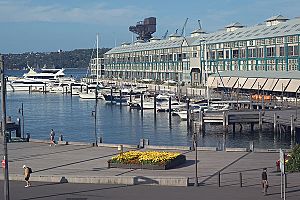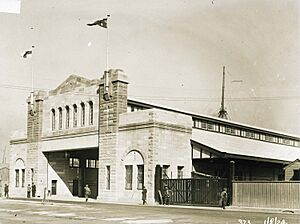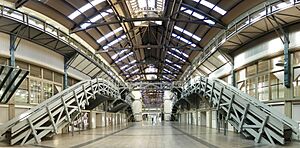Finger Wharf facts for kids
Quick facts for kids Finger Wharf |
|
|---|---|

The Finger Wharf and marina in Woolloomooloo Bay
|
|
| Location | 6 Cowper Wharf Road, Woolloomooloo, City of Sydney, New South Wales, Australia |
| Built | 1910–1916 |
| Architect | Henry D. Walsh |
| Owner | NSW Maritime |
| Official name: Woolloomooloo Finger Wharf; Woolloomooloo Wharf | |
| Type | State heritage (built) |
| Designated | 18 April 2000 |
| Reference no. | 1437 |
| Type | Wharf |
| Category | Transport - Water |
| Builders | Sydney Harbour Trust |
| Lua error in Module:Location_map at line 420: attempt to index field 'wikibase' (a nil value). | |
The Finger Wharf is a very old and important wharf located in Woolloomooloo, a suburb of Sydney, Australia. It was once a busy place for ships and passengers. Today, it is a modern complex with a marina, apartments, a hotel, and restaurants.
This amazing structure was designed by Henry D. Walsh and built between 1910 and 1916. It is also known as the Woolloomooloo Finger Wharf or Woolloomooloo Wharf. The wharf is famous for being the longest timber-piled wharf in the world! It is owned by NSW Maritime, a government agency in New South Wales. It was added to the New South Wales State Heritage Register on 18 April 2000, which means it is a protected historical site.
For about 70 years, the Finger Wharf was a key spot for exporting wool. It also played a big role during the World Wars, as troops left from here. After the wars, many new migrants arriving in Australia first stepped onto land at this very wharf. Now, it's a popular and stylish place to live, stay, and eat.
Contents
History of the Finger Wharf
The Woolloomooloo Finger Wharf was built during a time when many large finger wharves were appearing. It stands where Sydney's first fish market used to be, from 1872 to 1910. The wharf was built for the Sydney Harbour Trust, which was created in 1900. This Trust helped organize and rebuild the many wharves around Sydney Harbour.
Building the Wharf
Construction of the jetty began in 1910 and was mostly finished by 1913. Henry D. Walsh, the Trust's chief engineer, designed this huge building on the waterfront. A 30-metre (98 ft) extension was added to the wharf in 1916. More work, like building roads and repairing the wharf, continued until the early 1920s.
A Busy Working Wharf
For much of the 20th century, the Finger Wharf was a very active working wharf. It had two large sheds, each linked to a ship's berth. These berths were numbered 6 and 7 on the east side, and 8 and 9 on the west side.
The wharf became one of the main places for sending out wool. It was also where Sydney's only "wool dumps" were located. These machines compressed wool bales using hydraulic power. The wharf could handle some of the largest ships entering Sydney Harbour.
World Wars and Migrants
During World War I and World War II, the wharf was a crucial point. Troops boarded ships here to travel to different parts of the world for the wars.
After the wars, the wharf continued to be important. Shed No. 7 was updated in 1956 to become a passenger terminal. This part of the wharf was one of Sydney's main passenger wharves. It was often the first place new migrants saw when they arrived in Australia.
Decline and Rescue
By the 1970s, new container ports with bigger facilities meant the wharf was used less and less. By the 1980s, the wharf was empty and falling apart. In 1987, the NSW Government decided to tear it down.
However, many local people did not want the wharf to be demolished. When demolition work was supposed to start in January 1991, locals blocked the entrance. Unions also put a "Green ban" on the site. This meant workers were not allowed to help with the demolition.
Because of this strong public protest, the government changed its mind. They decided to renovate the existing wharf instead. It would become a special hotel with guestrooms, suites, and private homes. Walker Corporation took on this big renovation project.
The Wharf Today
The hotel was first called "W Sydney - Woolloomooloo" and was the first "W Hotels" property outside the United States. Later, it became the "Blue Hotel" and is now leased to the Ovolo hotel group. The complex also has several restaurants and bars.
Many famous people have lived in the apartments at the Finger Wharf. These include actor Russell Crowe and media personality John Laws.
What the Finger Wharf Looks Like
The Woolloomooloo Finger Wharf is built on strong turpentine timber piles. It is 410 metres (1,345 ft) long and 64 m (210 ft) wide. The main building on the wharf has two levels of sheds. These sheds are on either side of a central covered roadway.
About halfway along its length, an open area crosses the building. This area links the two outer sides of the wharf. The gates, gateposts, and fence at the entrance might be the only parts left from the old Cowper Wharf complex from the 1800s.
The building is easy to spot because of its three long, parallel, pitched roofs. These roofs cover the two sheds and the central roadway. The walls have a pattern from the building's structure and the way the panels are arranged.
Unique Features
The Port of Sydney was able to build strong timber structures because it had a small tidal range and access to the best hard timbers in the world. The Finger Wharf is said to be the largest remaining timber pile wharf in the world. It is also the only wharf in Sydney with a central roadway built on timber piles. It is the biggest all-pile finger wharf ever built in Sydney.
The wharf still has some interesting old industrial equipment. It originally had eight electric bale elevators and four electric lifts. Today, it has the only electric goods conveyors in the state that run from the central roadway to the upper level. It also has one of the oldest working electric lifts in Sydney.
At the north end, there used to be a carpenter's workshop. Now, there is a modern concrete and steel apartment building there, separate from the main wharf. On the west side, there is a walkway along the wharf, with a marina and restaurants at the south end. On the east side, there is a road for cars to access a car park for residents.
The Ovolo hotel takes up most of the southern part of the wharf building. The rest of the structure is mainly made up of apartments.
Why the Finger Wharf is Important
The Woolloomooloo Finger Wharf is very important for its history, its size, how it was built, and the old equipment it still holds. It has the largest and most impressive timber wharf building in Sydney Harbour. It shows the history of Woolloomooloo and how important the wool industry was in Australia during the 1800s and early 1900s.
Engineering and Construction
The wharf is a great example of a timber engineering structure. Its scale is unmatched in Australia and rare worldwide. It also shows how Australian timbers were used in huge sizes and amounts. These timbers were so durable that they are still standing today.
The structure also shows old engineering and construction methods. The surviving equipment, like the electric goods conveyors and old electric lifts, shows how goods were handled in the past.
Historical Connections
The wharf is important for its links to Australia's involvement in both World Wars. It was where troops left and returned. It also has a special connection with immigrants, as it was their first arrival point in Australia.
The sheer size of the structure and the quality of its construction are amazing. Many people in the community showed how much they valued the wharf when they protested against its demolition.
The Woolloomooloo Finger Wharf was listed on the New South Wales State Heritage Register on 18 April 2000 because it met several important criteria:
- It shows the history of New South Wales: It is the only surviving finger wharf built and rebuilt in Woolloomooloo between the 1880s and 1920s. It also shows patterns of industrial development and its connection to both World Wars. It was the largest wharf built by the Sydney Harbour Trust.
- It shows great design and technical skill: It is an excellent example of its type, with amazing details, design, and size. It was an innovative Australian version of foreign wharf designs.
- It has a strong connection with the community: The strong public reaction against its demolition shows how much the community values this structure.
- It can teach us about history: The area is part of the Aboriginal "Eora" territory, which is reflected in the name "Woolloomooloo." The wharf also contains old machinery from the early 20th century that is very significant. It also has a large amount of Australian hardwood timber.



